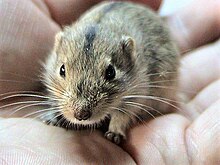Lagurus (rodent)
|
Lagurus Temporal range: Late Pliocene to Recent |
|
|---|---|
 |
|
| Steppe lemming (Lagurus lagurus) | |
| Scientific classification | |
| Kingdom: | Animalia |
| Phylum: | Chordata |
| Class: | Mammalia |
| Order: | Rodentia |
| Family: | Cricetidae |
| Subfamily: | Arvicolinae |
| Tribe: | Lagurini |
| Genus: |
Lagurus Gloger, 1841 |
| Type species | |
|
Mus lagurus Pallas, 1773 |
|
| Species | |
|
See text. |
|
See text.
Lagurus is a genus in the subfamily Arvicolinae (voles, lemmings, and related species). Together with the closely related Eolagurus, it forms the tribe Lagurini. Lagurus includes a single living species, the steppe lemming (Lagurus lagurus) of central Eurasia. The North American sagebrush vole (Lemmiscus curtatus) has also been included in Lagurus, but is likely not closely related. The earliest fossils of Lagurus, allocated to Lagurus arankae, appear in the Late Pliocene. Two other fossil species, Lagurus pannonicus and Lagurus transiens, are thought to be part of a lineage that led to the living steppe lemming.
...
Wikipedia
